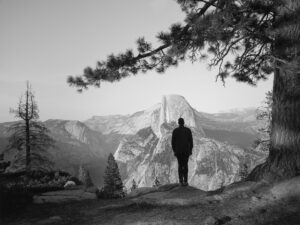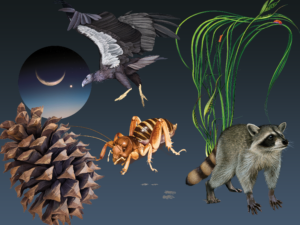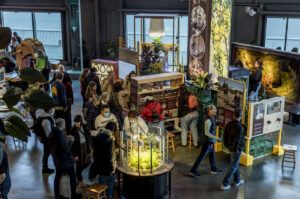
Looking out at Monterey Bay over a stretch of shoreline punctuated by algae-covered outcroppings of rock, I breathed in deeply, focusing on the waves as they broke and receded under a clear spring sky. Amid the chaos of the COVID-19 pandemic, the scene calmed my nerves and my mind. The ceaseless, steady rhythms of the water wrested my attention away from concerns about health, finances, and the challenges of adjusting to a new and restricted way of living. Although I couldn’t completely jettison these worries, in that moment the ocean filled my thoughts.
But I wasn’t at the beach. In fact, this experience occurred almost a month after my last visit to a Pacific shore and more than 100 miles away. I was watching the waves undulate on a 13-inch laptop screen in my bedroom, backed by the sound of light traffic outside and the usual whirring household appliances. This was a guided meditation video, part of the Morning MeditOcean series produced by the Monterey Bay Aquarium. It represented just one of many attempts by shuttered California art and science institutions to bring more of their programming online during this time, a list that also included a video walk-through of the Palo Alto Art Center’s Rooted: Trees in Contemporary Art exhibition and We Players’ Alice’s Adventures in Wonderland audio-play podcast, in lieu of the theater company’s postponed performance in Golden Gate Park.
Each MeditOcean video (which you can still access through the Aquarium’s YouTube channel) is approximately 15 minutes long and uses the institution’s various live cams to provide a quarantine-era maritime meditation aid. In addition to Monterey’s rocky shore, the videos feature sea nettles, moon jellies, and scenes from the open sea and kelp forest exhibits. The content is similar to many guided meditations, focusing on the breath, presence, and non-judgment, but the Aquarium-centric visuals serve a greater function than beautiful backgrounds for mindfulness. The guide, named only as Emily, weaves them skillfully into her narration, so that the jellies, waves, and kelp themselves become objects of reflection.
One evening, I found myself gently placing my doubts, anxieties, and restlessness atop the pulsating bell of a Pacific sea nettle, as it drifted through its tank and out of the video’s frame. Another day, the trance-like oscillations of the giant kelp helped me connect with my body, taking a weight off my chest and helping me feel more at ease. The strands of kelp, adorned with silvery fish and meandering sharks, swayed with a smooth cadence that mirrored my own breath, further enriching the meditative experience. The MeditOcean videos provided a surprising and much-needed outlet for my yearning to be outdoors—which, common as it had been before, became even stronger as quarantine wore on.
It’s well established among science researchers that spending even limited time in natural environments improves our mental and physical health, heightening cognition, decreasing stress and blood pressure, and increasing self-esteem and emotional well-being. Many of us intuitively know this to be true; hence, our rush to the outdoors during the early days of the Bay Area lockdown. But with many parks closed and travel restricted, I instead sought refuge in virtual nature, wondering whether similar benefits might be gained through remote engagement.
A 2017 study conducted at the University of New England in Australia suggests that the answer is yes. Researchers presented participants with one of three short videos depicting either wild nature, urban nature, or the urban built environment. Viewers of the wild or urban nature videos experienced lower levels of negative emotions than those who watched the built environment video, and viewers of the wild nature video also experienced higher levels of positive emotions. These results suggest that even virtual nature content has the potential to help us in times of need—whether through MeditOcean, live cams in the outdoors, nature shows, or perhaps (as I often write about in these columns) nature art.
Though the MeditOceans are mostly designed for use in the morning, I opted to watch them at night, when I most needed the tranquility, lightness, and connection that experiences in nature normally provide. Sure, my meditation sessions didn’t magically resolve my concerns; nor did they relieve me of all feelings of cabin fever or isolation. But they offered something more meaningful than the temporary escape of binge-watching a sitcom. These virtual moments in the water helped me find peace as I brought my day to an end, imagining a future moment when I’d return to the beach again.




